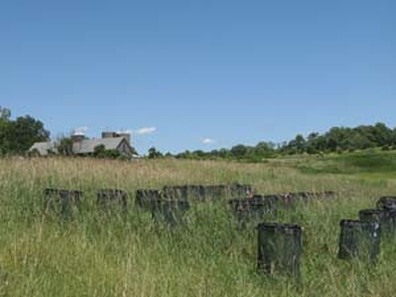|
--Jennie Miller, PhD Candidate
Classes have ended and we’re ramping up for summer fieldwork here in the Schmitz Lab. Five of the Schmitzers will be working in the field, carrying out innovative projects with lizards, spiders, grasshoppers and pollinators in Greece, Connecticut and Vermont. Colin departed three weeks ago for the islands of Greece, where he’s collecting preliminary data on lizard morphology in the presence of predators and rock wall refugia. Colin will be catching lizards and measuring every diagnostic metric he can think of to motivate his upcoming dissertation experiments. He left for Greece with some pretty cool field equipment, including snake tongs and a lizard bite balance. Hope the lizards are biting, Colin! Karin will be starting the sandbox experiment of her dissertation, which will run for the next few years. In June, she’ll transplant Solidago altissima plants from our greenhouse into cages in the fields of nearby Wallingford, CT. She’ll catch grasshoppers and stock the cages to examine their effects on the plants. Bryan will be studying how local adaptation in grasshoppers affects ecosystem response to climate warming. He’ll be comparing how grasshoppers from Connecticut (which likely adapted to handle warm temperatures) and grasshoppers from Vermont (expected to handle cooler temperatures) affect plant communities. Bryan plans to carry out a transplant experiment in which he’ll move CT grasshoppers to VT and likewise VT grasshoppers to CT and then examine differences in how the grasshoppers consume plants in field cages subjected to warmed conditions (simulating climate change). Bryan expects that the cool-adapted VT population of grasshoppers will be more phenotypically plastic in its response to warming. Rob has been prepping for fieldwork this summer by working in the lab, exposing Solidago plants to nitrogen and examining how the addition of nutrients to the soil impacts the rate of nitrogen cycling. He’ll be carrying out complimentary field experiments at the Yale Myers Forest, in which he’ll expose caged, old-field plots to different aboveground and belowground community compositions by altering the presence of herbivore grasshoppers, carnivorous spiders and microbial grazing springtails. Our undergrad Kassie will spend her first summer with the Schmitz Lab up at the Yale Myers Forest. She’ll be studying native pollinator community and plant-insect interaction webs across an anthropogenic impact gradient. Kassie is a big fan of native bees, which she believes are an important component of ecosystem health and are increasingly important as managed bee populations are in decline (especially the European honey bee Apis mellifera). This summer Kassie will spend her days watching bees, searching for correlative ecological, life history and landscape clues to the most important factors that support or disrupt pollinator communities. Good luck Kassie! Meanwhile, back in Greeley lab, Anne, Kevin and I will make ground-shaking progress in our spatial analyses of animal movement, distribution and predation patterns while sunbathing in the botanical garden to keep up with our labmates’ tans. Here’s to a fantastic summer!
14 Comments
10/7/2016 01:05:33 am
This article is really fantastic and thanks for sharing the valuable post.
Reply
12/27/2022 02:42:03 am
Enjoyed reading the article above, really explains everything in detail, the article is very interesting and effective. Thank you and good luck… This site is very helpful for me. I love that site and it is also an informative site
Reply
3/14/2023 05:19:34 pm
Working areas; installation, construction, replacement and plumbing services.
Reply
Leave a Reply. |
Archives
November 2019
Categories
All
|

 RSS Feed
RSS Feed
